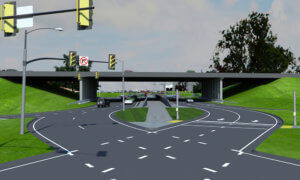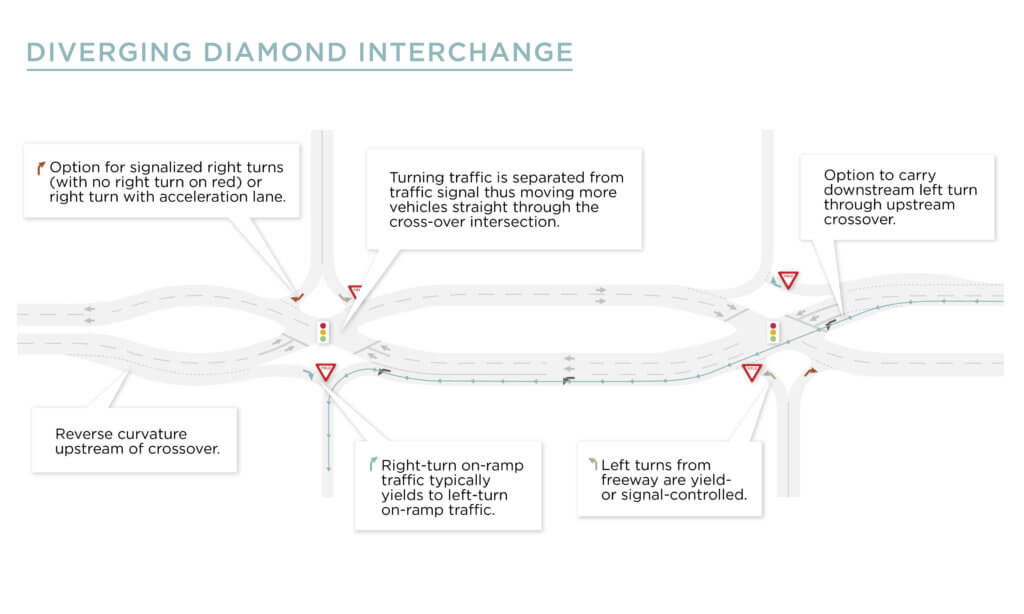Innovative Design of the Diverging Diamond Interchange
A fresh concept in interchange design, known as a Diverging Diamond Interchange (DDI), or Double Crossover Diamond Interchange, takes traffic safety and efficiency to a new level. “In a traditional diamond interchange, there are approximately 26 conflict points that can lead to traffic crashes,” explains Wade Greiman, PE, Transportation Business Unit Leader for Snyder & Associates. “DDIs have just 14 conflict points. Fewer conflict points mean fewer opportunities for vehicles to collide, resulting in a safer, more efficient flow of traffic.”
In a DDI, traffic is shifted from the right side of the road to the left side of the road at each intersection between the interchange ramps and side road. This means left-turning traffic doesn’t cross paths with oncoming traffic, so the chance for a collision is reduced. Once left turn intersections are cleared, traffic is brought back to the right side of the road. This simple concept is shown in the image, below.
Extensive Safety & Operational Benefits of Diverging Diamonds
Similar to the concern with roundabouts, DDIs utilize an unfamiliar traffic pattern that can create apprehension and fear for some drivers. Driving on the left side of the road may feel counterintuitive and even hazardous. In reality, DDIs provide numerous safety, operational, and cost benefits over traditional diamond intersection designs, including:
- Reduced collision potential and increased safety by reducing the number of times vehicles cross paths. In particular, left-hand turns through opposing traffic are eliminated
- Improved sight distance when turning
- Reduced potential for wrong-way movement onto freeway ramps, an ongoing problem on our nation’s highways
- Increased left turn capacity without needing additional lanes
- Improved traffic flow and safety by reducing the number of traffic lights
- Increased bicyclist and pedestrian safety by routing active transportation users through the median or along the roadway
- Reduced congestion, resulting in reduced fuel consumption and air pollution
- Reduced construction time with little to no additional right-of-way needed to retrofit an existing interchange
Signage and pavement markings are used throughout DDIs to help guide drivers as they become acclimated. However, Greiman says public outreach is also essential. “DDIs are unfamiliar for many people, so public engagement is important. Addressing public concerns and questions early on helps garner support. Modeling and animation technology can be particularly useful because it gives drivers an idea of what it will be like to drive through the area once it’s complete.”
Success Generates Bright Future for Diverging Diamond Interchanges

Using Luxology and Adobe Photoshop, this image was created to assist with public engagement for the E. 1st Ave./I-35 DDI project currently underway in Ankeny. Snyder & Associates design technicians also use Microstation, LumenRT, Sketchup, Adobe Premiere Pro, and Illustrator to create videos and graphics.
It’s been nearly a decade since the first DDI was implemented in Springfield, Missouri, and so far the results are encouraging. A 2011 performance evaluation conducted by the Missouri DOT yielded positive feedback from Springfield drivers, with 80 percent of people reporting that traffic flow had improved. In its findings, the Missouri DOT shared that total crashes went down by 46 percent in the first year of operation. Left-turn crashes were entirely eliminated and right-angle crashes were reduced by 72 percent.
In 2016, Carlos Sun, professor of civil and environmental engineering at the University of Missouri, along with colleagues across the country, published the first in-depth safety analysis comparing DDIs to traditional diamond configurations. After analyzing over 28 years worth of crash and other site data prior to DDI conversion and over 19 years of data post-DDI installation at seven U.S. locations, the group determined that:
- Diverging Diamond Interchanges reduce the number of traffic crashes by 33 percent
- Crashes resulting in injury and fatality are reduced by approximately 60 percent
While it was the first research of its kind and more is likely necessary, all signs point to DDIs as an efficient, effective, and most importantly, life-saving, intersection design. As they become more common, the unfamiliar will become second nature. With positive reviews from the Federal Highway Administration, as well as communities and agencies throughout the country, DDIs are on track to become the preferred method to route high volume traffic for years to come.
Reflecting on the Interstate 35 & East 1st Street DDI configuration the Snyder & Associates team helped design, Greiman is excited to be a part of a project that will transform the safe, efficient movement of traffic for the City of Ankeny, the Iowa Department of Transportation, and the traveling public.
“We continually keep the goal of zero fatalities in mind as we design improvements for our nation’s roadways. The DDI has reduced the possibility of vehicles backing up on the exit ramps as they move onto East 1st Street, greatly improving traffic flow. It has also reduced rear-end collisions at this location,” he shares. “It’s very rewarding to know that what we do today will serve the traveling public well as Ankeny continues to grow.”

